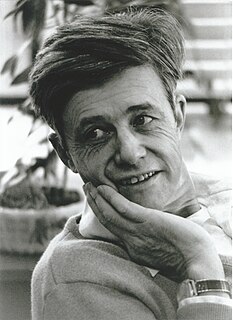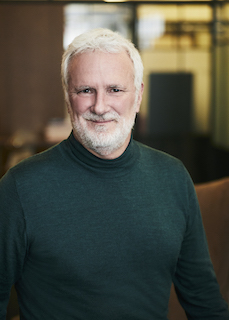APL is a programming language developed in the 1960s by Kenneth E. Iverson. Its central datatype is the multidimensional array. It uses a large range of special graphic symbols to represent most functions and operators, leading to very concise code. It has been an important influence on the development of concept modeling, spreadsheets, functional programming, and computer math packages. It has also inspired several other programming languages.
The Association for Computing Machinery (ACM) is a US-based international learned society for computing. It was founded in 1947 and is the world's largest scientific and educational computing society. The ACM is a non-profit professional membership group, claiming nearly 100,000 student and professional members as of 2019. Its headquarters are in New York City.

Frederick Phillips "Fred" Brooks Jr. is an American computer architect, software engineer, and computer scientist, best known for managing the development of IBM's System/360 family of computers and the OS/360 software support package, then later writing candidly about the process in his seminal book The Mythical Man-Month. Brooks has received many awards, including the National Medal of Technology in 1985 and the Turing Award in 1999.

John Warner Backus was an American computer scientist. He directed the team that invented and implemented FORTRAN, the first widely used high-level programming language, and was the inventor of the Backus–Naur form (BNF), a widely used notation to define formal language syntax. He later did research into the function-level programming paradigm, presenting his findings in his influential 1977 Turing Award lecture "Can Programming Be Liberated from the von Neumann Style?

Kenneth Eugene Iverson was a Canadian computer scientist noted for the development of the programming language APL. He was honored with the Turing Award in 1979 "for his pioneering effort in programming languages and mathematical notation resulting in what the computing field now knows as APL; for his contributions to the implementation of interactive systems, to educational uses of APL, and to programming language theory and practice".

Roger D. Moore was the 1973 recipient of the Grace Murray Hopper Award from the Association for Computing Machinery (ACM). It was given "for their work in the design and implementation of APL\360, setting new standards in simplicity, efficiency, reliability and response time for interactive systems."

Roger Hui is a computer scientist and codeveloper of the programming language J.

ACM SIGGRAPH is the international Association for Computing Machinery's Special Interest Group on Computer Graphics and Interactive Techniques based in New York. It was founded in 1969 by Andy van Dam.

Arthur Whitney is a Canadian computer scientist most notable for developing three programming languages inspired by APL: A+, k, and q, and for co-founding the U.S. companies Kx Systems and Shakti Software.
I. P. Sharp Associates (IPSA) was a major Canadian computer time-sharing, consulting and services firm of the 1970s and 1980s. IPSA is well known for its work on the programming language APL, an early packet switching computer network named IPSANET, and a powerful mainframe computer-based email system named 666 Box, stylized as 666 BOX. It was purchased in 1987 by Reuters Group, which used them until 2005 as a data warehousing center for business data.
Lawrence (Larry) Moser Breed is a computer scientist, artist and inventor, best known for his involvement in the programming language APL.
The programming language APL is distinctive in being symbolic rather than lexical: its primitives are denoted by symbols, not words. These symbols were originally devised as a mathematical notation to describe algorithms. APL programmers often assign informal names when discussing functions and operators but the core functions and operators provided by the language are denoted by non-textual symbols.
The Eckert–Mauchly Award recognizes contributions to digital systems and computer architecture. It is known as the computer architecture community’s most prestigious award. First awarded in 1979, it was named for John Presper Eckert and John William Mauchly, who between 1943 and 1946 collaborated on the design and construction of the first large scale electronic computing machine, known as ENIAC, the Electronic Numerical Integrator and Computer. A certificate and $5,000 are awarded jointly by the Association for Computing Machinery (ACM) and the IEEE Computer Society for outstanding contributions to the field of computer and digital systems architecture.

Eugene Edward McDonnell was a computer science pioneer and long-time contributor to the programming language siblings APL and J.
Scientific Time Sharing Corporation (STSC) was a pioneering timesharing and consulting service company which offered APL from its datacenter in Bethesda, MD to users in the United States and Europe.
James A. Brown was manager of the group within IBM responsible for the programming language APL2 program product. APL2 was first available on IBM mainframe computers in 1980, and was later available under Linux, Unix, and Windows. In 1993, Brown received the Kenneth E. Iverson Award for Outstanding Contribution to APL from the Association for Computing Machinery.
Edward H. (Ed) Sussenguth Jr. was an American engineer and former IBM employee, known best for his work on Systems Network Architecture (SNA). He was also a contributor to the architecture of IBM's Advanced Computer System (ACS).
Robert (Bob) Bernecky is a Canadian computer scientist notable as a designer and implementer of APL. His APL career started at I.P. Sharp Associates (IPSA) in 1971.

John Morley Scholes (1948–2019) was a British computer scientist. His professional career was devoted to the development of the programming language APL. He was the designer and implementer of direct functions.
A direct function is an alternative way to define a function and operator in the programming language APL. A direct operator can also be called a dop. They were invented by John Scholes in 1996. They are a unique combination of array programming, higher-order function, and functional programming, and are a major distinguishing advance of early 21st century APL over prior versions.








